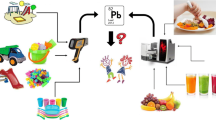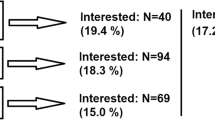Abstract
Two hundred and fifty-seven urine samples collected from school children living in the Manzini region, Swaziland, were analysed for lead (Pb), using a graphite furnace atomic absorption spectrometer. The mean urine lead concentration for the urban schools ranged from 0.038–0.040 μg⋅ml−1, while that for the rural schools ranged from 0.017–0.022 μg⋅ml−1. The observed range shown by the urban schools was above the normal (for healthy humans) urine lead concentration of 0.035 μg⋅ml−1. However, the mean urine lead concentration for the rural schools was found to be lower than this value. The mean urine lead concentration for the urban schools was significantly higher than that of the rural schools. The differences in the mean urine lead concentrations for boys and girls from both urban and rural schools were found not to be significant, despite the higher values shown by the girls. The difference in lead concentrations between urban and rural schools in Manzini was thought to be due to the traffic density within the urban area.
Similar content being viewed by others
References
Ahmed, N.S., El-Gendy, K.S., El-Refaie, S.A., Maecouk, N.A., Bakry, A.H., El-Sebae, H.J. and Soliman, S.A. (1973) Assessment of lead toxicity in traffic controllers of Alexandra, Egypt road intersection. Arch. Environ. Health 42(2), 92–7.
Barry, P.S. (1975) A comparison of concentrations of lead in human tissues. Br. J. Ind. Med. 32, 119–39.
Boeckx, R.L. (1986) Lead poisoning in children. Anal. Chem. 58, 274A.
Chenard, L., Turcotte, F. and Cordier, S. (1987) Lead absorption by children living near a primary copper smelter. Can. J. Public Health 78, 295–98.
Gobler, S.R., Maresky, L.S. and Rossouw, R.J. (1986) Blood lead levels of South African long distance road-runners. Arch. Environ. Health 41(3), 155–61.
Kopito, L., Byers, R.K. and Shwachman, H. (1967) Lead in hair of children with chronic lead poisoning. NewEngl. J. Med. 276, 949–53.
Lwenje, S.M., Okonkwo, J.O, Mtetwa, S.B., Gamedze, A., Mavundla, J.A. and Sihlongyane, M.M. (1999) Determination of urinary iodine in school children of the Hhohho region in Swaziland. International Journal of Environmental Health Research 9, 207–11.
Mahaffey, K.R. (1977) Quantities of lead producing effects in humans: sources and bioavailability. Environmental Health Perspect 19, 285–95.
Okonkwo, J.O., Lwenje, S.M., Mtetwa, V.S.B. and Mkhweli, T.B. (1999) Measurement of lead concentration in the hair of school children in the Manzini region, Swaziland. Intern. J. Environ. Studies 56 419–28.
Reeves, R.D., Jolley, K.W. and Buckley, P.D. (1975) Lead in human hair: relation to age, sex and environmental factors. Bull. Environ. Contam. Toxicol. 14, 579–87.
Schuhmacher, M., Domingo, J.L., Libet, J.M. and Corbella, J. (1991) Lead in children's hair as related to exposure to Tarragona Province, Spain. The Science of Total Environment 104, 167–73.
Sithole, N.S., Moyo, N. and Macheka, M. (1993) An assessment of lead pollution from vehicle emission along selected roadways in Harare Zimbabwe. Intern. J. Environ. Anal. Chem. 53, 1–12.
Swaziland Central Motor Registry. (1997) Report of registered vehicles.
Tsuchiya, K. (1979) Lead. In Handbook of the toxicology of metals (L. Friberg, G. Norberg and V. Vouk, eds.) Amsterdam: Elsevier-North Holland Publishers.
Underwood, E.J. (1971) Trace elements in human and animal nutrition, 3rd ed. New York and London: Academic Press.
Weiss, D., Whitten, B. and Leddu, D. (1972) Lead content in human hair. Science 178, 69–70.
Zafar, I.S. and Mirza, A.A. (2000) Lead in particulate deposits and in leaves of roadside plants, Karachi, Pakistan. The Environmentalist 20(1), 73–7.
Author information
Authors and Affiliations
Rights and permissions
About this article
Cite this article
Okonkwo, J.O., Lwenje, S.M., Mtetwa, V.S.B. et al. Determination of urinary lead in school children in Manzini, Swaziland, Southern Africa. The Environmentalist 21, 205–209 (2001). https://doi.org/10.1023/A:1017923219270
Issue Date:
DOI: https://doi.org/10.1023/A:1017923219270




